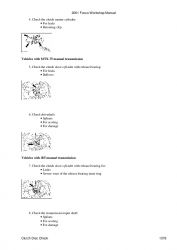Ford Focus 2001 Factory Service & Shop Manual
Catalog:
Model:
Complete workshop repair service manual with electrical wiring diagrams for 2001 Ford Focus. It's the same service manual used by dealers that guaranteed to be fully functional and intact without any missing page.
This Ford Focus 2001 service & repair manual (including maintenance, overhaul, disassembling & assembling, adjustment, tune-up, operation, inspecting, diagnostic & troubleshooting…) is divided into different sections. Each section covers a specific component or system with detailed illustrations. A table of contents is placed at the beginning of each section. Pages are easily found by category, and each page is expandable for great detail. The printer-ready PDF documents work like a charm on all kinds of devices.
30 Focus ECO - 3-door ECO
31 Focus ZX3 - 3-door ZX3
33 Focus LX - 4-door LX4
34 Focus SE - 4-door SE4
36 Focus ZTS - 4-door LTS
38 Focus SE - wagon SEW
P 2.0 SPI 121 4 Gasoline Ford
3 2.0 Zetec 121 4 Gasoline Ford
EXCERPT:
2001 Focus
Workshop Manual
Alphabetical Index
A B C D E F
G H I J K L
M N O P Q R
S T U V W Y
Table of Contents
1: General Information
00: Service Information
2: Chassis
04: Suspension
05: Driveline
06: Brake System
11: Steering System
3: Powertrain
03: Engine
07: Automatic Transmission
08: Manual Transmission, Clutch and Transfer Case
09: Exhaust System
10: Fuel System
4: Electrical
12: Climate Control System
13: Instrumentation and Warning Systems
14: Battery and Charging System
15: Audio Systems
17: Lighting
18: Electrical Distribution
19: Electronic Feature Group
5: Body and Paint
01: Body
02: Frame and Mounting
…
Control of shift operations
During a shift operation certain elements are released while others are actuated. Ideally this process takes place simultaneously (synchronously) to avoid jerky gear shifting.
The time for the shift operation should remain within the time limits provided.
When the shift operation is controlled conventionally, the pressure build up and reduction at the shift elements are set and defined for ideal conditions (synchronous shifting).
As there is no way of influencing the control in the event of different levels of wear in the shift elements, when the transmission has been used for a fairly high mileage it is possible that the pressure build up and reduction may no longer be synchronous.
The result or premature pressure reduction at the element to be switched off is an unwanted rise in the turbine shaft speed as the element to be switched on cannot transmit the input torque.
The result of delayed pressure reduction at the element to be switched off is an unwanted decrease in the turbine shaft speed as both shift elements transmit the input torque. In the process the torque is transmitted to the transmission housing through internal locking.
In both cases a jerk will be felt during the shift operation.
In addition, wear in the shift elements leads to a lengthening of the shift operation. Therefore, shifting takes longer when the transmission has accumulated a higher mileage.
Control of shift operations with ESSC
Ford Focus 2001 Factory Service Workshop Manual
…





